Dinger's Aviation Pages
Blackburn Skua and Roc Colour Schemes
First Prototype Skua
When it was first rolled out of the factory, the first, short-nosed, Skua prototype (K5178) had a natural metal finish with many differences in tone between the various metal panels, a distinct contrast to the more uniform finish of production Skuas. The prototype then had the fuselage painted in what has been described as "battleship grey" but may have been a pale green or blue colour. Whatever colour it was it had a very matt surface. The rudder was reported to be white but some reports say it was silver! Photos show the top of the wings to be a light colour, probably the same shade of white or silver as the rudder. There was a sweeping "swag" area of the "battleship grey" colour at the wing roots and the underside of the wings appears to be the "battleship grey" colour as well. Black serials were carried on the rear of the fuselage and the moveable rudder. Type "A" roundels were carried on the fuselage sides and the top and bottom of both wings. The rear of the propeller blades were black, while the front of the blades were natural metal. For display at the 1937 Hendon airshow, a large number "8" was painted on the side of the fuselage. This prototype does not appear to have had the black anti-slip walkways painted in the wing (the grey-painted "swag" may have shown where it was safe to tread).

First Skua prototype K5178, showing the lighter-coloured rudder and wing upper surfaces and the "swag" of the darker fuselage colour at the wing root. Notice the area of reflection on the fuselage roundel, showing it had a gloss or satin finish compared to the matt finish of the fuselage.
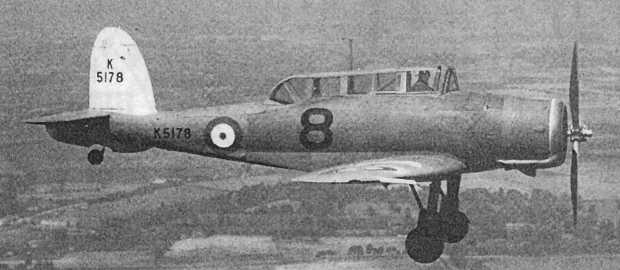
The number "8" was painted on the side of the fuselage for display in the "new types" enclosure at the 1937 Hendon airshow. Notice the way the undercarriage is raked back in flight.
Second Skua Prototype
The second Skua prototype had a uniform all-over finish with little reflection, looking more like light grey than silver. It was initially devoid of roundels and markings except for the serial on the moveable part of the rudder, it even lacked black walkways on the wings. Later, the serial number was moved from the rudder to the side of the rear fuselage and roundels were added to the fuselage sides and the top and bottom of both wings. A black anti-slip walkway was added to the wing root and this extended to the front of the wing (unlike production Skuas, where it stopped short). In many of the photos of the second prototype, after the serial had been moved to the fuselage, the movable part of the rudder appears much lighter than the rest of the aircraft, maybe silver or white.
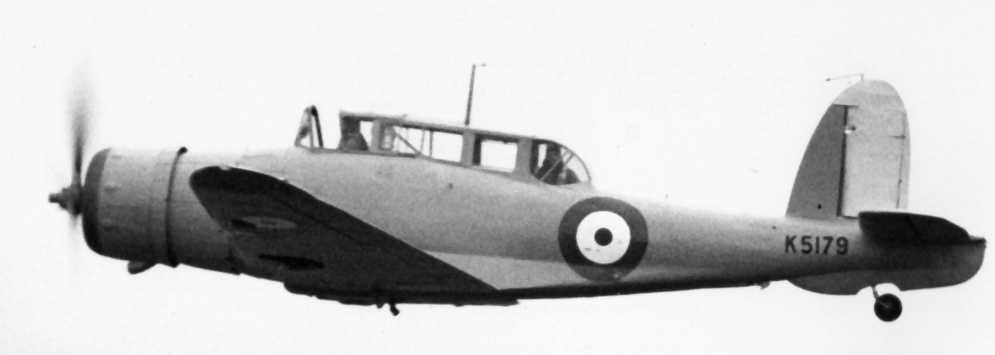
The second prototype (K5179), showing the lighter colour of the rudder.
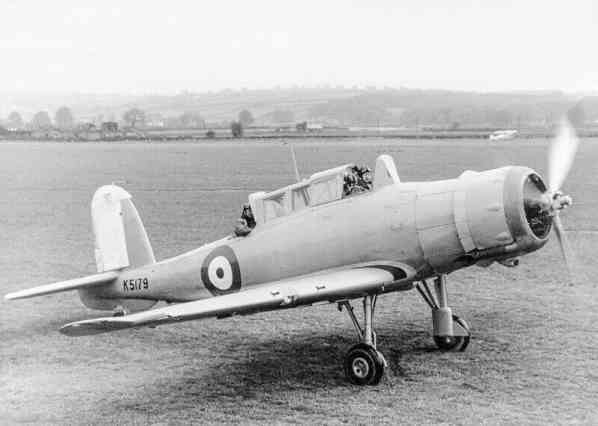
Another photo of the second prototype, again showing the different colour of the rudder. Notice the black walkway extends to the front of the wing.

Another photo of the second prototype, again showing the different colour of the rudder. Notice the black walkway extends to the front of the wing.
Silver Production Skuas and Rocs.
Before the outbreak of World War Two, production Skuas had, what looks like, a dull silver finish. The early Skuas were delivered from the Blackburn factory with this finish with just "type A" red-white-blue style roundels (the walkways at the wing root were black/grey non-slip paint). In one article, the noted aviation historian and expert on colour schemes ID Huntley put forward the suggestion that this was not silver at all, but a very light grey, "Cerrux Grey", a protective finish manufactured by the Cellon company (it should be stressed he only suggested it as one interpretation). In the mid-1930s it was usual for Royal Navy biplanes to have the fabric parts of their airframes "doped" and then finished off with silver paint, while the metal surfaces were painted Cerrux grey, so there would be some logic in the predominantly metal Skua being painted Cerrux grey. However, having examined many photos of earlier biplanes known to have had Cerrux grey as part of their schemes, I don't think it matches with what we see in photos of Skuas. Cerrux Grey was a very light shade of grey, bordering on white. On photos of biplanes that used it the Cerrux grey painted parts stand out as being much lighter than the silver doped fabric, making the fabric surfaces look comparatively dark. It is certainly noticeable, in all the photos of Skuas from this time, that the surfaces gave off little reflection and had a very uniform finish, without the difference in panel colouring observed on the first prototype or the Skuas under production at the Blackburn factory. The finish on the metal fuselage and wings matches the fabric-covered rudder and ailerons. The best explanation for the colour scheme I've seen is that suggested by author and Navy aviation expert Matt Willis: An undercoat on all the metal surfaces of the protective "Cerrux Grey" followed by an overpaint, including the fabric surfaces, of aluminium "dope" paint. This would give the more uniform "satin" finish observed in photographs. However, the central spinners on the propellors were often very highly polished; 803 Squadron seem to have polished their spinners till they sparkled! The collector rings around the front of the engine cowling and the exhaust pipe were a browny bronze colour. This turned darker the longer the aircraft was in use and often a band of lighter "silver" becomes apparent at the rear of the collector ring.
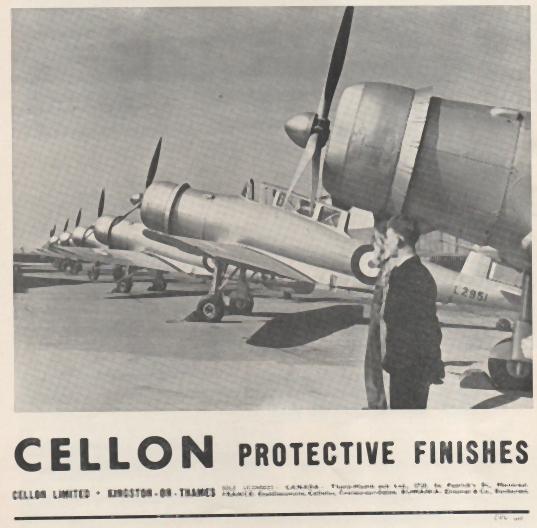
1939 advert for the Cellon company. Note that only the rear of the propeller blades are painted black, and even that does not reach all the way to the blade root.
The walkways on the wing roots look to have initially been painted with black non-slip paint, but this quickly wore away, even on Skuas that can only have been in service a few weeks. Later photos of old well-worn Skuas show solid black walkways suggesting some sort of rubber non-slip matting surface was later applied.
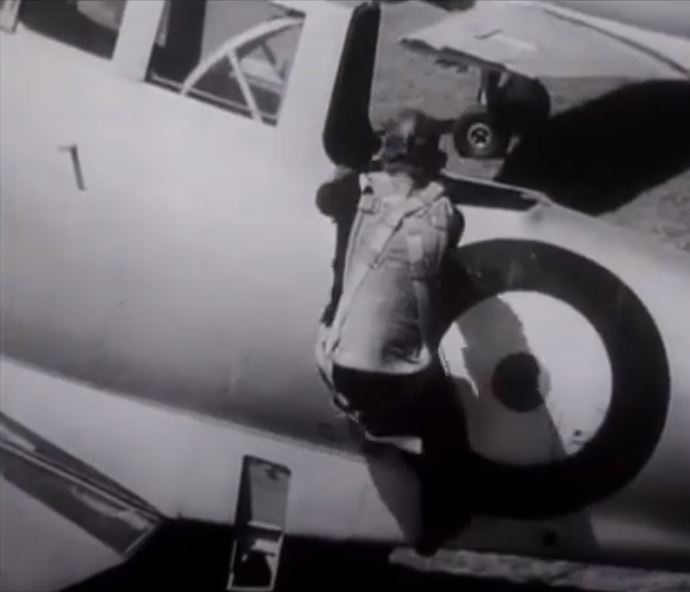
Getting into the back of a Skua, a pre-war publicity photo. Notice how the paint on the wing-root walkways has already worn away. Notice also the access step in its "down" position showing the area behind it to be a different colour; "interior green" or "zinc chromate" perhaps? Notice also the rod that stuck out from the fuselage.
Once issued to Royal Navy squadrons, Skuas were painted with bright identification stripes which varied from squadron to squadron. Flight and squadron leaders seem to often have had additional stripes on the rudder.
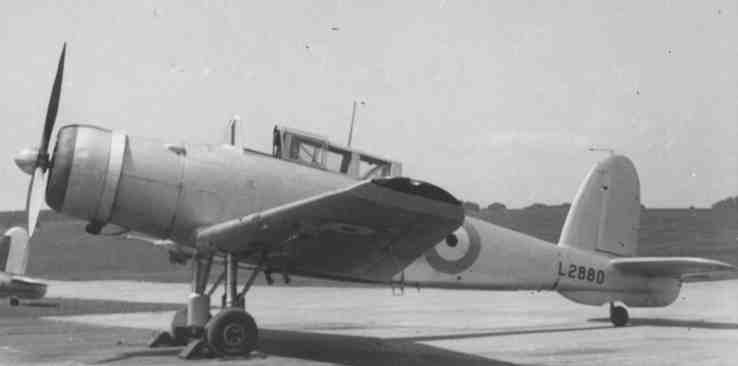
Skua L2880 at Worthy Down. Note the two colour bands on the upturned wingtips, probably red at the tip with white inboard of it.
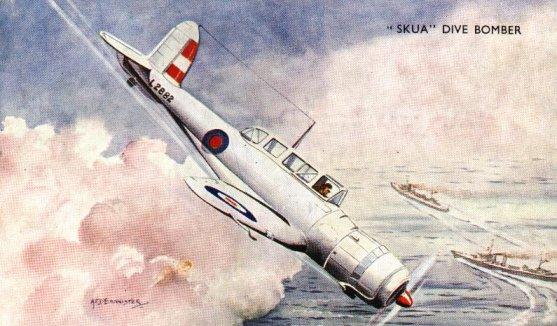

This contemporary postcard is probably an accurate representation of one particular Skua (the serial number L2882 is correct).
Unit three-letter identity codes (Air group/Carrier letter- Squadron number- Individual aircraft letter) were painted over the fuselage band. The letter A denoted HMS Ark Royal. L denoted HMS Illustrious, U denoted HMS Furious, G denoted HMS Glorious, E denoted HMS Eagle and R denoted HMS Argus.
The following codes are noted for the four squadrons that used Skuas for combat duties.
800 Squadron - A time with single identification letters then A6
801 Squadron - A period with no codes at all, then U6 then A7
803 Squadron -A7 (in use at the time of the silver Skua "photo shoot" as in the photo below) - then A8 (at the time of the Königsberg attack).
806 Squadron - L6. Formed specifically for use aboard the new carrier HMS Illustrious, the squadron had stopped using the carrier code by the time it was actually deployed for its shakedown cruise to Bermuda.
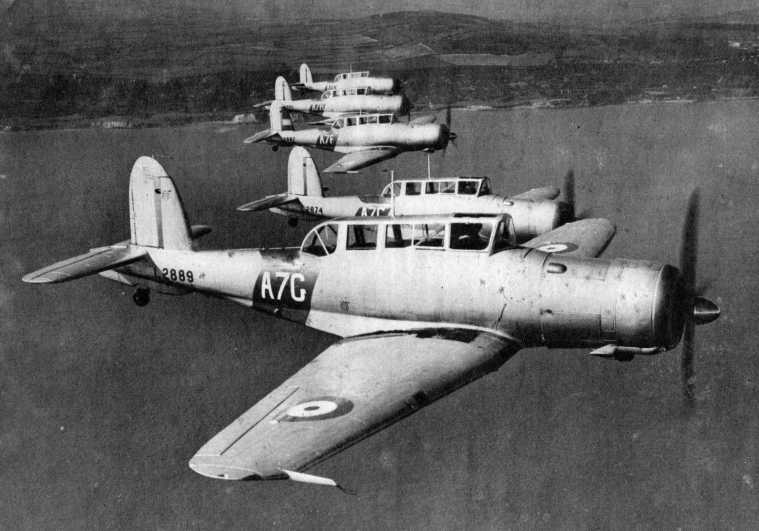
Pre-war shot of 803 Squadron Skuas. Their fuselage band was blue-red-blue. ID letters A=Ark Royal, 7 = 803 Sqdn, G = Individual aircraft letter. Notice the black wing-root walkways are already worn from use.
At the outbreak of war, there seems to have been no hurry to camouflage the Skuas in a disruptive pattern. Skuas operating from the Ark Royal retained the dull silver finish for the latter months of 1939, including the period the carrier operated in the South Atlantic searching for the Graf Spee.
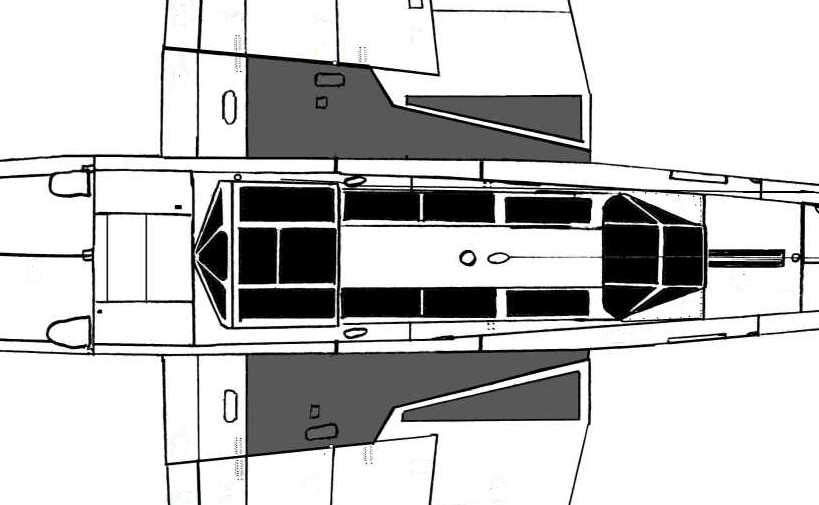
The pattern of the black, anti-slip walkways on the Skua and Roc (on the 2nd Skua prototype they extended to the leading edge of the wing). In photos of "silver" pre-war Skuas in 1939, the black anti-slip paint can often be seen to be already worn away revealing the bare metal underneath, on later photos of wartime Skuas it looks like the surface has been covered with some sort of black rubber non-slip covering. See more extensive plans at <this link> (PDF file).
The very early Rocs were delivered with the same silver finish as Skuas. However, the majority of Rocs were delivered already painted in camouflage colours. The Air Ministry specified which serial number Rocs were going to be delivered to Navy or RAF units and they received the appropriate camouflage scheme at the Boulton Paul factory, an "S1E" scheme for the Navy Rocs (explained below) and a brown & green RAF day-fighter scheme for those Rocs destined for RAF units. To illustrate this see the photo on page 160 of "Boulton Paul 1917-1961- Aircraft, Projects and Studies" by Les Whitehouse (see bibliography page); it shows a lineup of Rocs outside the Boulton Paul factory, painted in the two different schemes. It is noticable that on both schemes the fuselage roundels were of type "B". The roundels on the navy Rocs were smaller than the RAF ones.
Camouflaged Skuas and Rocs
By the spring of 1940, most Skuas had adopted camouflage. This was a scheme called "S1E" and was detailed for the Skua in Air Diagram AD1173 issued in March 1939 (reproduced on page 106/107 of Stuart Lloyd's "Fleet Air Arm Camouflage and Markings"). This detailed a camouflage scheme of extra dark sea grey and dark slate grey on the top of the wing and extending 1/3 of the way down the fuselage with all undersurfaces, fuselage sides and rudder in sky grey. The extra dark sea grey had a blue tinge to it. The term "dark slate grey" is misleading, since most people looking at this colour would identify it as a dull shade of green. Those people lucky enough to own copies of the wartime-produced "Aircraft of the Fighting Powers" will find the colours illustrated by colour chips on page XXIII of volume V. The discovery of a rare colour film of a Skua from early 1940 (see below for an example) illustrates this S1E scheme well.

This rare colour image of a Skua is courtesy of Øyvind Lamo who runs the Operation Skua website. It shows Skua L2991 (8Q) from 803 Squadron. The camouflage scheme seems to be a "mirror image" of the official S1E colour scheme. It was hit by gunfire in a dogfight with a Heinkel 111, over Åndalsnes in the Romsdalsfjord, on April 26th 1940. The aircraft made it to Ålesund, near the coast, and ditched in the harbour there. Still afloat, it was towed to a shipyard nearby and lifted ashore. The pilot, Lt.Cecil Howard "Kik" Filmer, survived and after the war, he went to live in Durban, South Africa. He died on 15th July 2007 at the age of 92. The Observer/Gunner Petty Officer K.G. Baldwin was hit during the dogfight and killed.
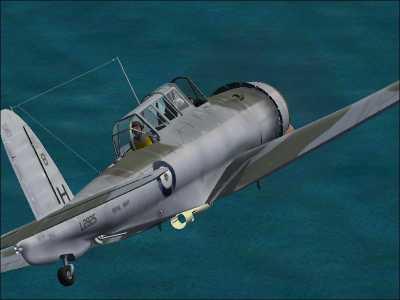
Jamie Tindall's rendering of the Skua camouflage scheme for Microsoft Combat Flight Sim 2.
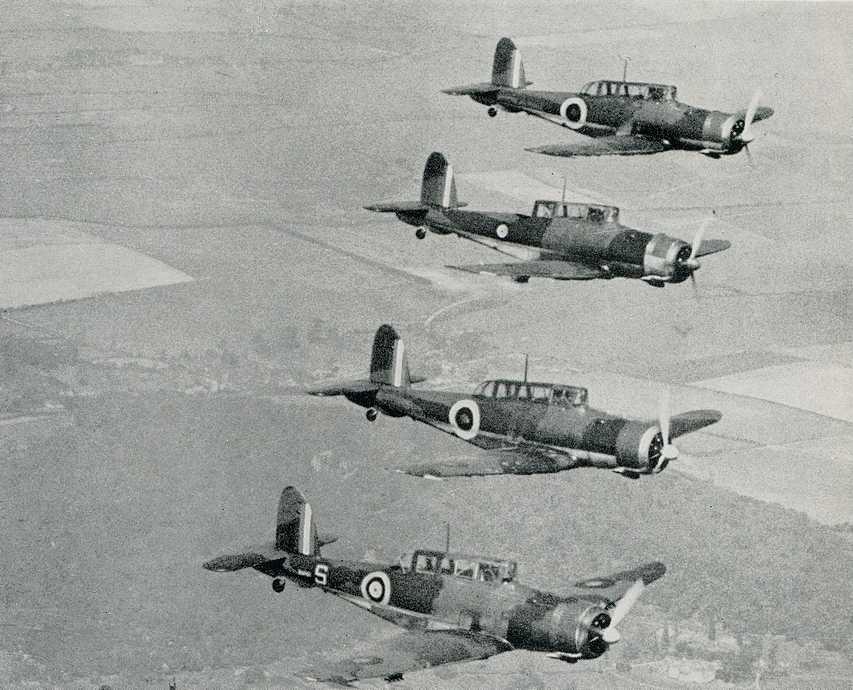
A formation of Skuas showing a whole range of fuselage roundel styles and major differences in the camouflage patterns. Notice the different hues of the engine collector rings. The nearest aircraft has a distinct lighter band at the rear of the collector ring.
When Skuas operated as fighters in defence of Scapa Flow and other naval bases they became an adjunct of RAF Fighter Command, so they adopted the RAFs scheme meant to aid the Royal Observer Corps to easily identify friendly fighters at height through binoculars. This entailed the port underside of the wing being painted black and the starboard white. When this half-black/white scheme was used it was usual for there to be no underwing roundels (although there seem to have been many exceptions). This black/white underside scheme was adopted very early in the war, even before the adoption of the S1E scheme, and black/white undersides are a feature of the otherwise silver Skuas operating from the Ark Royal in the search for Graf Spee in 1939 (a photo on page 145 of Stuart Lloyds "Fleet Air Arm Camouflage and Markings" clearly shows that it was a gloss black on the Ark Royal Skuas at this stage, probably because of a shortage of the regulation matt black). When the Skua squadrons adopted S1E the black/white underwing markings were retained and they were worn by most of the Skuas involved in the early Norwegian campaign and the Dunkirk operations but had been overpainted by the time of the attack on Scharnhorst.
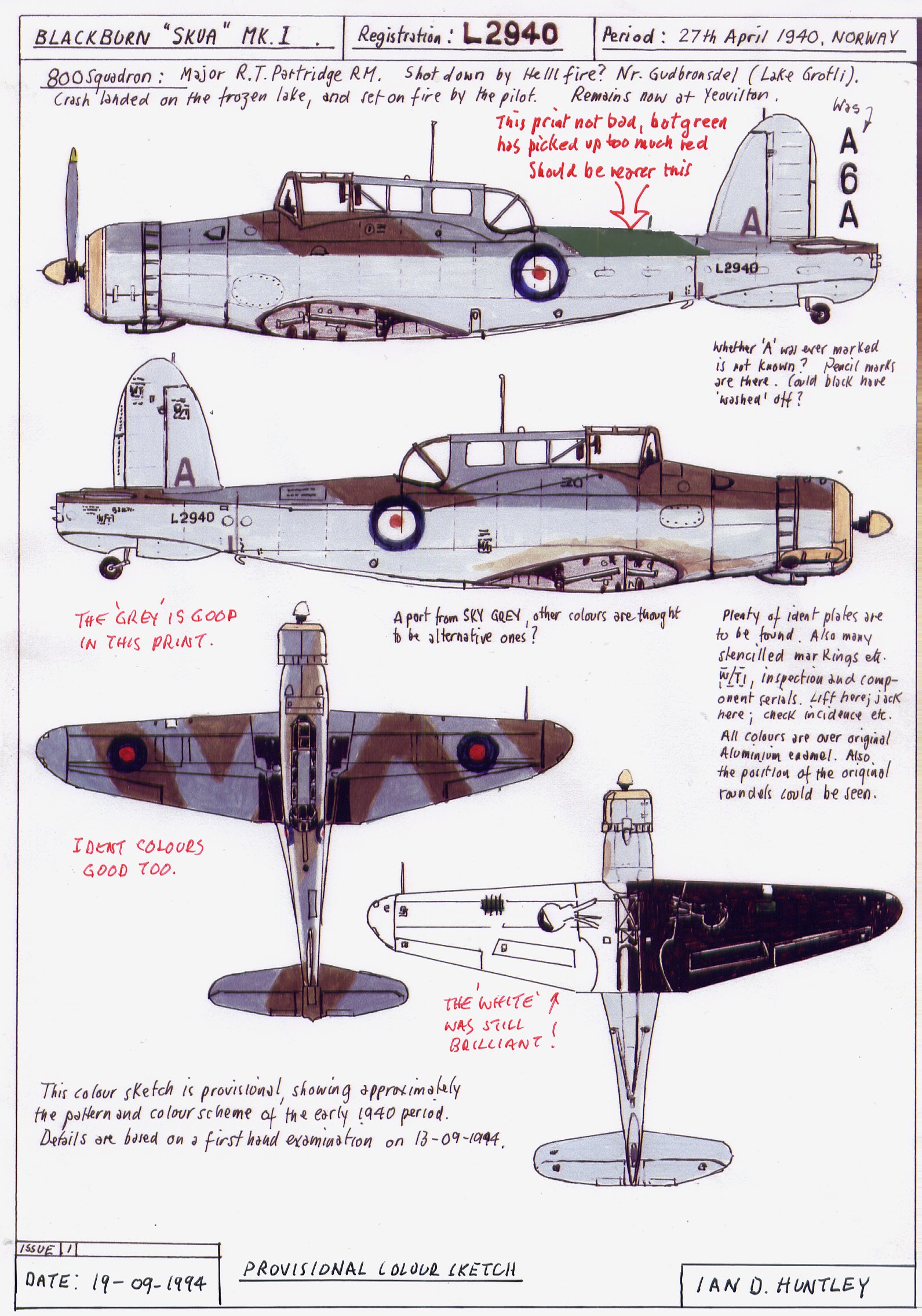
Above: The late, much-missed, I.D. Huntley's notes from an examination of the Skua at the FAA Museum Yeovilton. The upper camouflage pattern is exactly that specified in Air Diagram 1173 (scheme S1E) issued in March 1939.

This picture of a Skua (L3012 "K") being recovered from the sea off Bermuda reveals some interesting points - Note how the undercarriage and flap recess on the port side are painted black - This shows that at one stage the underside of the port wing was painted black - also it is just possible to make out the outline of a roundel on the port wing, showing through the overpainted light underside paint. For the story behind the picture see "The Myth of Black Sunday".
The three-letter identity code was carried vertically on the rudder. The "carrier group" identity letter was ordered to be dropped before the start of the Norwegian campaign, and some squadrons dropped the squadron code as well (for example in the colour photo above the Skua only carries "Q" the individual aircraft identification letter). So for the initial stages of the Norwegian campaign (April 1940), the rudder fin would usually be a light grey with either one individual aircraft code letter at the base, and perhaps an additional Squadron number above it. From May 1940 red-white-blue flashes started to be applied to the fixed part of the aircraft fin. It also became usual for the fuselage roundel to have an outer yellow ring (style "A1"). At this stage, the individual aircraft code letter was usually retained at the base of the fin painted over the fin flashes. The movable rudder was still in the light grey colour. The fin flashes were a feature of Skuas operating in the Narvik campaign and the attack on the Scharnhorst (May-June 1940).
In June the black and white underwing identification colours were being ordered to be overpainted with the colour "Sky" (a duck-egg-green colour distinct from the sky grey). This colour was applied under the wings and the extreme bottom of the fuselage, but the sides of the fuselage remained the slightly lighter "Sky Grey" colour.
There is an excellent article "Plumbing the Depths" in the December 2011 edition of Scale Aircraft Modeller written by Matt Willis about the camouflage scheme of Skua L2896 which was shot down in the raid on the Scharnhorst in June 1940, and recovered in 2011. The aircraft had the letter "A" in green, outlined in black, on the fin and the underside paint seems to be a distinct pale blue colour, not the "sky" that might be expected, leading to speculation about the colour being mixed from blue and white because of a lack of the "official" colour. This pale blue colour covered the underside of the wings, the extreme bottom of the fuselage and the area of the fuselage under the tailplane, leaving the fuselage sides sky grey. The presumption is that the other Skuas on the raid would have carried similar paint schemes.
At some stage, during June/July of 1940, the single aircraft recognition letter started to be put on the fuselage side, rather than on the fin (When 806 Squadron operated from HMS Illustrious in July 1940 they had the letters on the fuselage). At a later stage, during the late summer or early autumn of 1940, the moveable rudder started to be painted in the darker upper-surface camouflage colours.
Skuas had started off with the front of the propeller blades left a natural metal colour with only the rear painted black (to stop reflections from distracting the pilot). This black paint did not reach the root of the blade, but stopped short, in a curved line. At this stage, the propellers did not have yellow tips. Starting sometime in May or June 1940, the whole of the propeller started to be painted black with yellow tips, however, this was not universal and photos of Skuas on HMS Ark Royal show them still with shiny metal fronts to their propellers in late 1940 (although they seem to have yellow tips). Examination of the Skua propeller at the Highland Aviation Museum indicate that the initial painting of black over the back side of the propeller blade had been over a primer of dull red oxide paint which showed through where the black paint chipped off.
The colour scheme of the Navy Skuas, with the dark camouflage only covering the top third of the fuselage, was similar to that used by German Bf109s. During the Dunkirk actions, there were alarming instances of losses to friendly fire by the Skua squadrons involved. As 1940 wore on the photographic record shows that on many Skuas the dividing line between the top dark camouflage and the lighter underside had crept down to halfway down the fuselage and was often wavy or blurred, rather than the ruler-straight demarcation usually used earlier in the year (for examples see page 112, 121 and 125 of Stuart Lloyd's "Fleet Air Arm Camouflage and Markings").
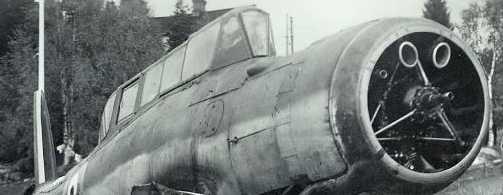
Skua L2942 crash-landed in Sweden after a raid on Trondheim in September 1940. Notice how the camouflage extends almost halfway down the fuselage and ends in a blurred, rather than ruler-straight line.
To complicate matters those Skuas and Rocs allocated to the RAF-administered Anti-Aircraft Co-operation Units (AACU) were usually camouflaged in the standard RAF brown and green colours, with the dark camouflage extending all the way down the sides of the fuselage. Some of those aircraft would have usually started with an all-over black and yellow "target tug" scheme and the black and yellow undersurfaces were usually retained by Skuas and Rocs operated by the AACU.
In August 1940 Royal Navy aircraft were ordered to switch to the new officially promulgated "Temperate Sea" scheme (Air Ministry Memorandum S5506) - This was upper surfaces of the familiar extra dark sea grey and dark slate grey and underside of "Sky". As mentioned earlier the extra dark sea grey had a distinct blue tinge and the dark slate grey would have been identified as a dull green by most observers. "Sky" was meant to be a pale duck-egg green, but shortages of the regulation paint meant it was often mixed locally from whatever was available, resulting in duck-egg blue and light blue shades. S5506 also formalised the fin flash into a rectangle 24 inches long and 27 inches high (e.g. red white and blue stripes 8 inches wide). However, the demarcation line between the upper camouflage and the lower was still not formalised and Skuas and Rocs sported a range of variations. It was not until March 1941 that DTD 144 was issued which specified that the dark upper camouflage should extend down the sides of the fuselage to meet the camouflaged upper surfaces of the wings.
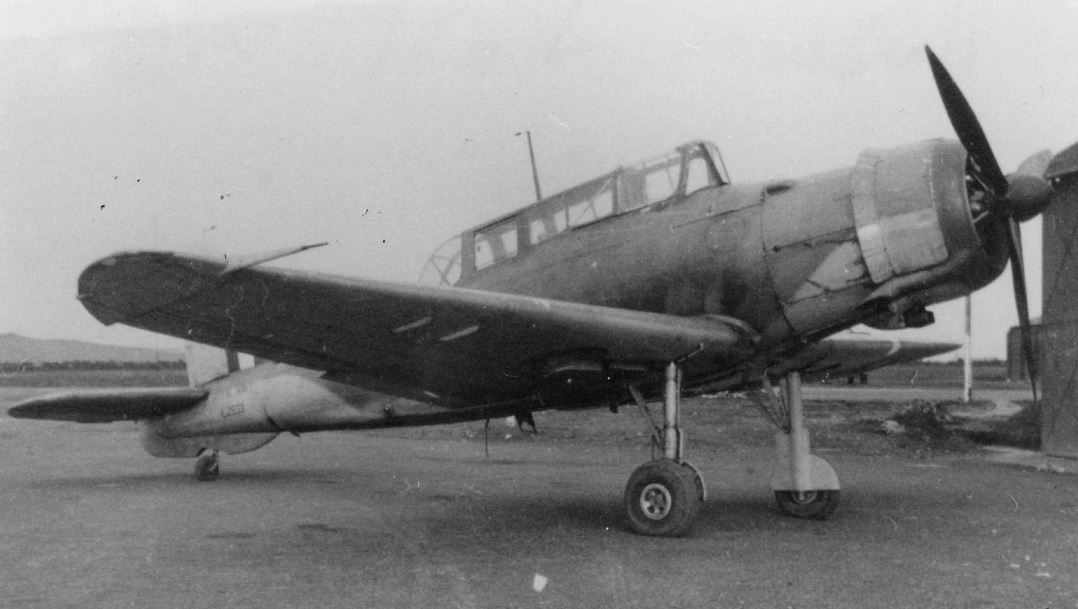
This Skua (L2933) was reportedly on Air Sea Rescue duties from the airfield at Andreas on the Isle of Man. It features a demarcation line between the upper and lower camouflage that curves down to meet the wing root. In the original photo, it can be seen that at this stage both the front and back of the propeller blades were black with light (presumably yellow) tips. Note the extra thickness of the bullet-proof glass on the front windscreen.
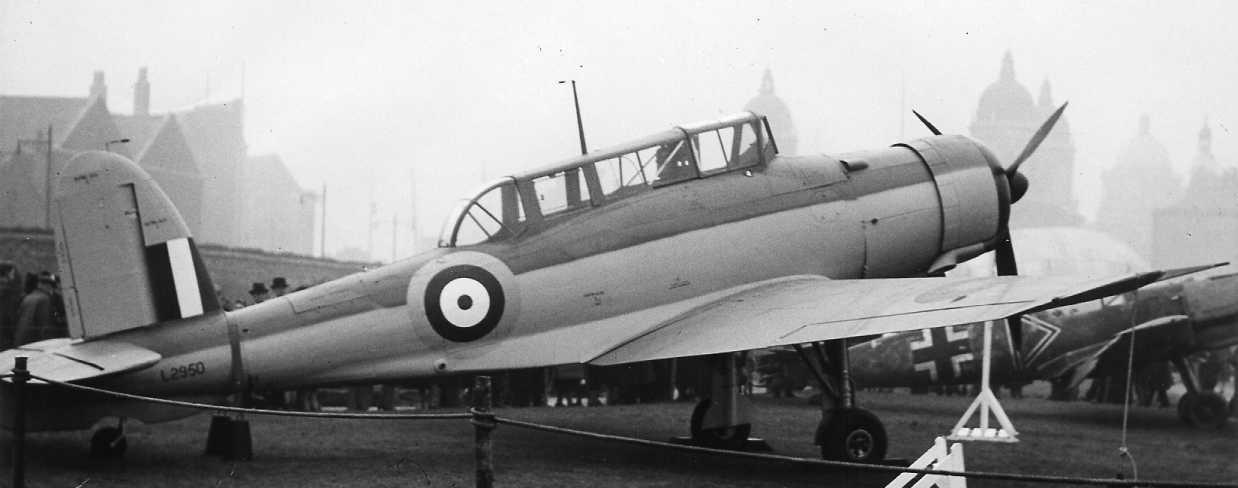
Skua L2950 is in immaculate condition, cleaned up and repainted to go on display alongside a captured Bf109 in the city of Hull, not far from the Blackburn factory where the Skuas were produced. The stencilling on the fuselage and tailplane is particularly evident. Note the extra armoured glass and metal side plates added to the windscreen of Skuas starting in the second half of 1940.
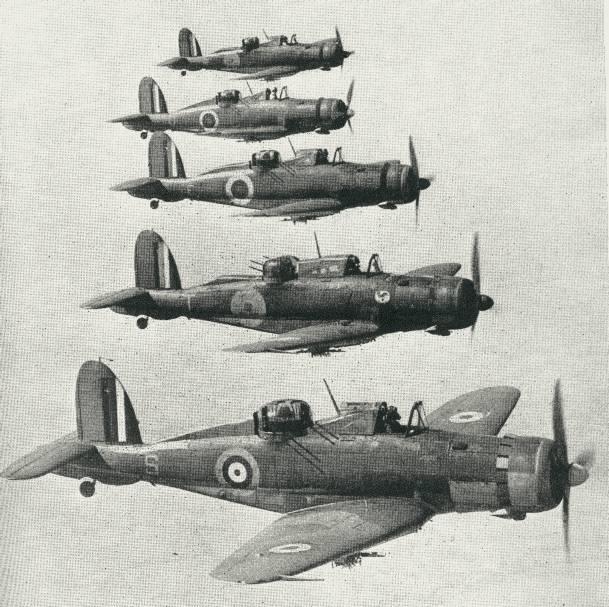
Rocs in formation. The use of fin flashes means this photo was taken after May 1940, but it is impossible to tell from the photo if the aircraft were in early camouflage or the later "temperate sea" scheme. Note the difference in styles of Roundel - "A" type, "B" type and "B" type with "A1" yellow outer ring. There seems to be little standardisation. Notice the distinct thin band at the rear of the engine exhaust collector ring.
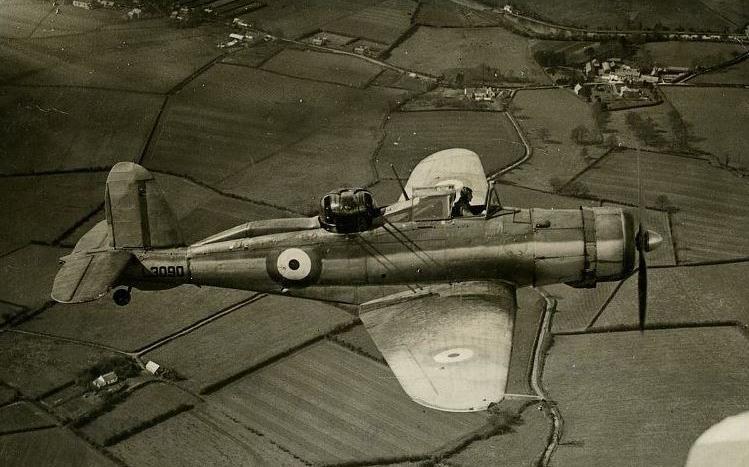
Nice view of a Roc with type "A" roundels on both the wings and fuselage. Notice the line where the tail assembly joins the fuselage. The production of tail assemblies of both the Skua and Roc were subcontracted to the General Aircraft Company and brought in as complete units.
In December 1940, it was ordered that all Skua aircraft operated by the Air Branch of the Navy should have "Royal Navy" painted in black, in letters 4 inches high, above the serial numbers on the rear fuselage.
By the second half of 1940, it had become usual for the two-figure squadron/individual aircraft code to be applied to the leading edge of the wing near the fuselage. This was presumably to help with the quick identification of individual aircraft in the cramped space of an aircraft carrier hangar. In the photo below, a still from the film "Ships with Wings" showing a Skua with wings folded on the lift of HMS Ark Royal, you can see the code "6K" marked on the leading edge of the wing.

When the Ark Royal operated Skuas in the Mediterranean in the second half of 1940, it can clearly be seen the undersides of the wings and the extreme underside of the fuselage were painted a darker shade - leaving the sides of the fuselage light grey (see photo below). This seems to concur with the colour scheme of the Skua recovered from the sea bed at Trondheim in 2008, with the bottom of the fuselage in "Sky" (albeit perhaps a bit closer to light blue than duck-egg green).

Another still from "Ships with Wings", shows a Skua below deck on the Ark Royal. You can clearly see the bottom of the fuselage is a different colour to the sides. Notice that only the rear of the propeller blades are painted black and they seem to have yellow tips.
In Matthew Willis' book "Blackburn Skua and Roc" there are a series of fascinating photos of Skuas and Rocs in what seems to be an all-over matt black finish with low-visibility type "B" roundels (pages 40-43 in my edition). These photos were apparently taken at Eastleigh airfield (now Southampton airport) in the winter of 1939/40. Just why such a colour scheme was necessary at this particular time is a mystery. If it was a year later there would be an easy explanation as at the time there was a plan for a Skua dive-bomber attack on the Scharnhorst and Gneisenau in Brest harbour to be carried out at night (but with a full moon).
TIGER STRIPE SKUAS
The "Tiger Stripe" scheme of wide diagonal yellow and black stripes was for aircraft on target-towing duties. It was formalised by an Air Ministry memorandum dated 7th March 1938. The Blackburn Aircraft paperwork for the scheme identifies the colours as "Identification Yellow" and "Night". Many of the late production Skuas were delivered from the factory already painted in this scheme. In 1940 such aircraft in Britain would have had their top surfaces camouflaged, leaving only the undersurfaces black and yellow. Blackburn Roc target towing aircraft in South Africa retained their all-over Tiger Stripe scheme throughout their service.
"Tiger Stripe" yellow and black colours.


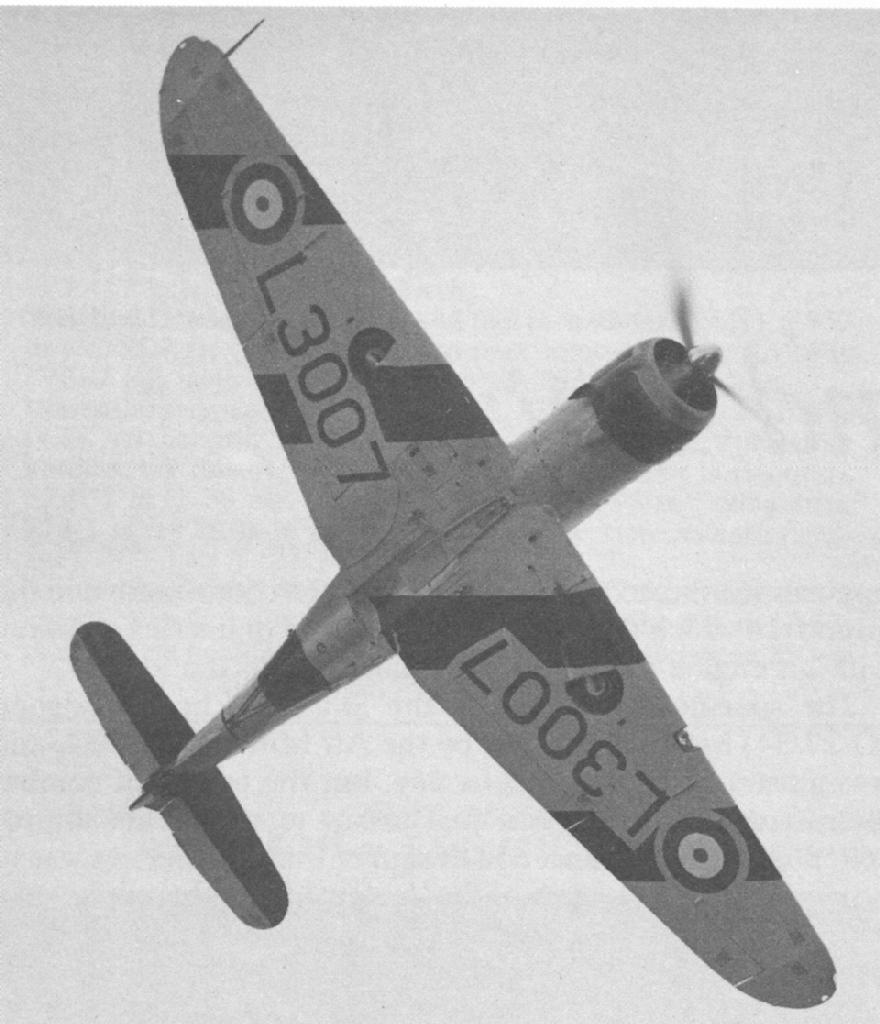
Skua L3007 in target tug "tiger stripe" colours. Contrary to some reports, L3007 was not the first Skua delivered in this scheme, that was L2987 (see page 20 of Mattew Willis' "Blackburn Skua & Roc").
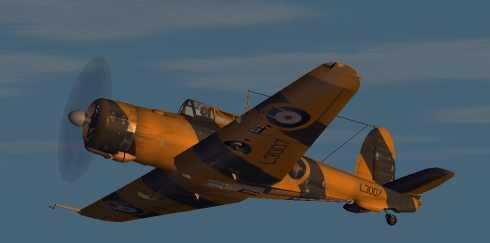
This is an impressive rendition of the target tug colour scheme by Jamie Tindall for Microsoft Flight Sim 2.
One colour scheme that has caused a lot of discussion over the years was an "experimental" scheme of silver with red stripes. It seems that when Frog issued their 1939 acetate plastic model of the Skua they misconstrued the available black-and-white photos of Skua L3007 and mistook the yellow and black "tiger stripe" scheme for silver and red. So the instructions in the kit detailed a red and silver scheme that never actually existed. This scheme then found itself referenced in later articles with speculation that such a dazzling scheme might have been required to locate the aircraft if it ditched at sea. This ended up being included in the text of the authoritative Putnam's title "Blackburn aircraft since 1909" by AJ Jackson. An article by Philip Moyes in the December 1970 edition of Aircraft Illustrated Magazine puts the record straight as far as the true colours of L3007 in the photos. My thanks to Kim Elliott for showing me the Frog instruction sheet for reference.
For further reading on the subject of Skua and Roc colour schemes.
Guides to Skua colours and camouflage schemes are provided in articles written by the late I. D. Huntley for Scale Aircraft Modelling magazine. They appeared in the November 1987, December 1993 and May 1994 editions. I am indebted to Nikos Tselepides for making me aware of these articles (via Jamie Tindall). Ian D. Huntley also wrote a short article dealing specifically with the black and yellow "Tiger Stripe" Skua scheme in the September 1974 edition of Aircraft Illustrated Magazine, this quotes an official Air Ministry memorandum from March 1938 on how manufacturers should paint aircraft destined for target-towing duties.
Matthew Willis' magnificent book "Blackburn Skua and Roc" published by Mushroom Models has by far the best collection of photos of the Skua. It has a section of colour photos including the remains of L2980 in the FAA museum and further colour images of L2991 at Alesund in April 1940. There are no less than 33 colour profiles by Kjetil Aakra.
Stuart Lloyd's masterly work "Fleet Air Arm Camouflage and Markings - Atlantic and Mediterranean Theatres 1937-1941" is a good reference and has lots of high-quality black and white photos of Skuas and Rocs in service, along with 6 colour profiles of Skuas and Rocs. It is the most complete reference yet to the orders issued by the Air Ministry and Admiralty regarding the colour schemes worn by Skuas, Rocs and the other FAA aircraft of the period.
Model Aircraft Monthly - October 2007 Edition features a potted history of the Skua by Tony O'Toole which has more colour shots of L2991 along with a page of photos of L2942 after its internment in Sweden.
As mentioned earlier the article "Plumbing the Depths" by Matt Willis in the December 2011 Scale Aircraft Modeller Magazine has details of the scheme used on Skua L2896 recovered from Trondheim Fjord in 2008.
Philip Moyes article "Jazzed-up Skua" in the December 1970 edition of Aircraft Illustrated Magazine addresses the issue of the non-existant red and silver scheme and has a nice 1/72 black and white plan by A. Granger showing the "Tiger Stripe" scheme.
There is a more in-depth bibliography at <THIS LINK>
